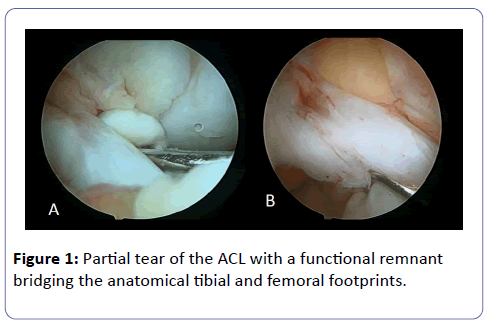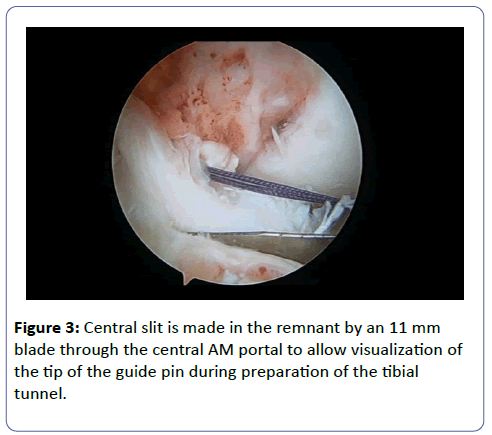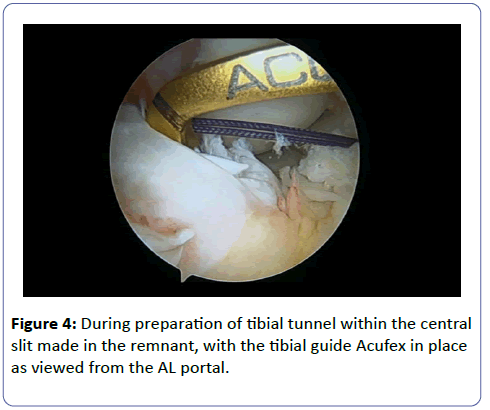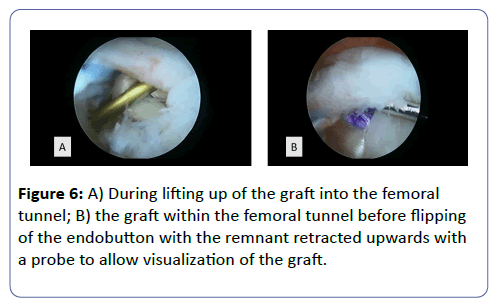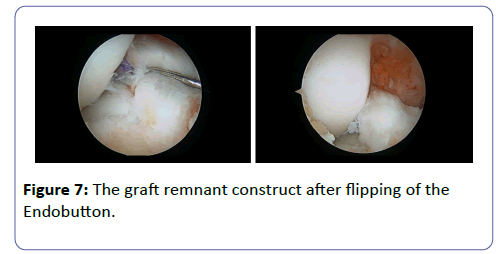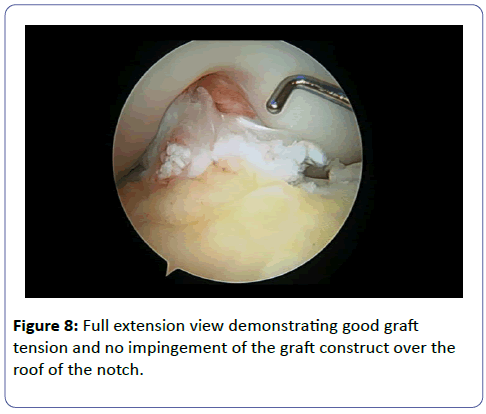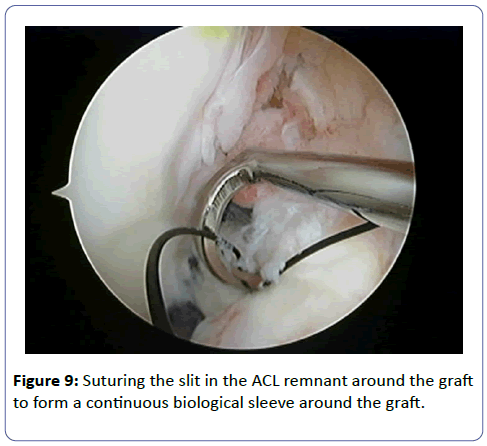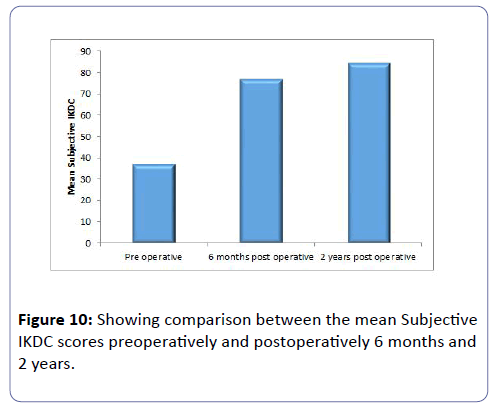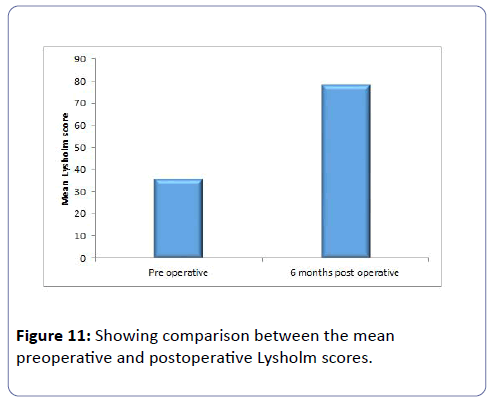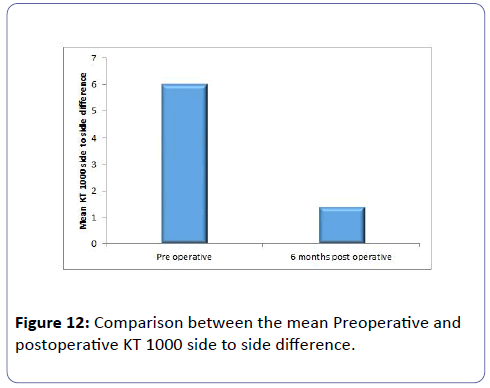Midterm Results of Remnant Preserving ACL Reconstruction, Using Hamstring Tendon Autograft and a Special Surgical Technique
Mohamed Mahmoud Abouheif
DOI10.4172/2471-8416.100044
Mohamed Mahmoud Abouheif*
El Hadra University Hospital, Department of Orthopedic surgery, Alexandria University, Egypt
- *Corresponding Author:
- Mohamed Mahmoud Abouheif
El Hadra University Hospital
Department of Orthopedic surgery
Alexandria University, Egypt
Tel: +201011564298
E-mail: mohamed_heif@yahoo.com
Received date: November 10, 2017; Accepted date: November 17, 2017; Published date: November 25, 2017
Citation: Abouheif MM (2017) Midterm results of remnant preserving ACL reconstruction, using hamstring tendon autograft and a special surgical technique. J Clin Exp Orthop Vol.3:44. doi: 10.4172/2471-8416.100044
Copyright: © 2017 Abouheif MM. This is an open-access article distributed under the terms of the Creative Commons Attribution License, which permits unrestricted use, distribution, and reproduction in any medium, provided the original author and source are credited.
Abstract
Introduction: Preservation of the ACL remnants may have a beneficial biological and biomechanical function.
Material and methods: Thirty patients with partial tear of the ACL with a remnant bridging the anatomical femoral and tibial footprints. This ACL remnant was preserved and augmentative reconstruction was done using a special surgical technique. The patients were clinically assessed pre and post operatively.
Results: There was statistically significant improvement of subjective as well as objective clinical assessment parameters. This improvement continued until the end of follow up two years postoperatively.
Conclusion: Remnant preserving ACL reconstruction results in excellent midterm functional outcome.
Keywords
ACL; Remnant preserving; Reconstruction; Surgical technique
Level of Evidence
IV case series
Introduction
Scientists and orthopaedic surgeons have been working hard trying to optimize the technique of ACL reconstruction to have better functional outcome. In standard ACL reconstruction, the ACL remnant, which does not have the potential for spontaneous healing, is debrided to allow creation of correct femoral and tibial tunnels without the risk of impingement or the formation of the cyclops lesion. Most ACLs rupture in their proximal half, while most studies found that mechanoreceptors are concentrated in the subsynovial layer near the tibial insertion of the ACL [1-7].
During arthroscopy for ACL reconstruction, sometimes a thick remnant might be found bridging between the femoral and tibial footprints. This considerable remnant has been found in some experimental and clinical studies to be of biomechanical value. Moreover, recent studies have reported that ACL remnants contain several types of mechanoreceptors and that they may contribute to proprioceptive function [2,3].
We believe that preservation of the ACL remnants might facilitate the post-operative proprioceptive function. In addition, may have a biomechanical effect by contributing to the knee stability. This remnant is also rich in blood vessels consequently it may accelerate the cellular proliferation and revascularization of the grafted tendon, a process that is called ligamentaization. The later might have a positive impact on the functional outcome [8].
In order to avoid the risk of impingement of the graft remnant construct against the notch or the PCL, we developed a special surgical technique that allows the passage of the graft within the substance of the remnant. To optimize this biological reconstructive benefit, the synovium is sutured over the graft-remnant complex to create a closed synovial tube of the reconstructed ACL extending between the tibial and the femoral anatomical footprints [8].
This prospective clinical trial was conducted to study the midterm functional outcome after ACL reconstruction with remnant preservation.
Material
This is a prospective clinical trial. Between June 2011 to June 2014. One hundred patients had arthroscopy for suspected ACL injury. Only 30 cases had considerable ACL remnant fibers bridging between the femoral and tibial foot-prints that couldn’t be considered a definite bundle. This ACL remnant was preserved and augmentative reconstruction was done by a special surgical technique using the doubled semitendinosus and gracillis tendon autograft as an ACL substitute and an accessory anteromedial portal for complementary reconstruction of the missing part of the ACL within the anatomical footprint.
Inclusion criteria
Patients with isolated ACL injury undergoing arthroscopy for a reconstructive procedure within one year of the injury episode.
Exclusion criteria
• Patients requiring revision reconstruction of the ACL
• Multiple ligament knee injuries
The characteristic demographic features of the studied group was shown in Table 1. All of the patients gave a history of sport related injury or a similar event followed by knee swelling which had subsided partially with time with residual knee pain (100% of cases) and occasional giving way (in 17 patients 56.6%). The average duration before surgery was 6.5 months range from (4 to 10) SD 1.7.
| Variables | Number | Percent |
|---|---|---|
| Age <25 25-30 >30 |
12 15 3 |
40.0 50.0 10.0 |
| Range Mean S.D. |
20-32 25.4 3.57 |
|
| Sex Male Female |
28 2 |
93.3 6.7 |
| Preoperative knee pain | 30 | 100 |
| Preoperative giving way No Frequent Occasional |
2 11 17 |
6.7 36.7 56.7 |
Table 1: Characteristic demographic features of the studied group
Methods
Preoperative assessment
Preoperatively the patients may show weakly positive pivot shift test with apprehension, positive anterior drawer (AD) test and/or Lachmann test depending on the presence or not of a functional remnant bridging between the femoral and tibial foot prints.
Pre-operative instrumented laxity testing using the KT-1000 arthrometer (MED metric, San Diego, CA, USA) with the knee at 30 degree flexion using an anterior force of 133 N (30 Ib) applied to the tibia. Both the injured and non-injured sides were tested and the average side to side difference was 6 mm, SD 0.67.
Preoperative MRI revealed either a definite diagnosis of partial ACL injury or a sprain.
All the patients were assessed clinically using the subjective IKDC 2000 score, Lysholm score and the objective IKDC 2000 grading system. The average preoperative IKDC score was 37, while the average preoperative Lysholm score was 35.8. Preoperatively 16 patients (53.3%) were graded C according to the objective 2000 IKDC grading system. While 12 patients 40% were graded D and only two patients 6.7% were graded B.
The final diagnosis of partial ACL injury was reached during intra-operative arthroscopic evaluation of the pattern of the ACL injury before choosing the proper reconstructive procedure:
• The presence of considerable ACL remnant fibers bridging between the anatomic femoral and tibial foot prints. In this case, we proceed for remnant preserving ACL reconstruction that aims at preserving the remaining functional remnant and doing complementary reconstruction of the remaining part of the ACL within the anatomical footprint using a doubled autogenous Hamstring (Gracillis and semitendinosus) graft substitute and our special surgical technique for remnant preservation (Figure 1) [12].
• The presence of a definite well preserved bundle whether AM or PL bundle means that we are going to do selective bundle augmentation reconstruction for the missing one. The difference between this and the previous category is that small diameter autograft substitute 7 or 8 mm may be sufficient so that the Semitendinosus tendon is harvested at first and doubled then its diameter is measured before proceeding for Gracillis tendon harvest.
• For complete tear of the ACL we proceed for anatomical single bundle ACL reconstruction using the trans-accessory femoral portal technique.
Endobutton CL (Smith & Nephew Endoscopy, Andover, MA) for fixation of the graft in the femoral tunnel, and Interference screw for fixation of the graft in the tibial tunnel.
Surgical technique
After standard diagnostic arthroscopy and checking for meniscal injuries, and the state of the articular cartilage. If a functional remnant is found bridging between the tibial and femoral footprints, an accessory anteromedial portal (AAM) is made under direct vision from the lateral portal just above the medial meniscus taking care to leave enough space not to damage the articular cartilage of the medial femoral condyle [8].
Retraction of the functional remnant is done either by a probe or a prolene suture loop to allow perfect visualization of the femoral anatomical footprint; the two ends of the suture loop were passed out of the accessory AM portal (Figure 2).
Using a microfracture awl (Smith and Nephew) a pilot hole was made within the femoral footprint complementary to the remaining fibers, this hole was checked by switching the portals and direct visualization through the AM portal. The passing pin was then introduced through the accessory portal (AAM) under visualization from the AL portal aiming towards the pilot hole within the anatomic footprint. Concomitant to this was maximum flexion of the knee to ensure that the passing pin gets out of the anterolateral femoral cortex outside the territory of the common peroneal nerve. This was followed by drilling using the 4.5 cannulated drill bit. Then the femoral tunnel length is measured, and then the proper Endobutton CL length is chosen. Overdrilling using a drill bit equal to the diameter of the doubled hamstring autograft, the depth of overdrilling is determined by the following; Overdrilling depth=(tunnel length-CL length+6 mm which is the length of the endobutton) [9-13].
A wire loop was passed into the femoral tunnel then it was retracted till its end was just apparent at the end of the tunnel.
After making the femoral tunnel, then using a scalpel introduced through the medial portal a central slit is made in the remnant fibers to allow visualization of the tip of the passing pin during making of the tibial tunnel (Figure 3).
Then using the Smith and Nephew tibial guide adjusted to 60° with mild increase of the vertical inclination of the tibial tunnel, this allowed the tibial guide pin to get out within the tibial anatomic foot print and within the central slit made within the ACL remnant fibers (Figure 4) [9,13].
Then by using a curved hemostat the wire loop end coming out of the femoral tunnel is passed through the central slit in the remnant fibers and then out of the tibial tunnel using a grasper or probe (Figure 5). Then the prepared graft substitute was lifted up the tibial tunnel and then into the femoral tunnel under direct visualization then flipping of the endobutton is done as usual (Figure 6) [8,9].
Then in about 30° knee flexion the tensioned graft is fixed in the tibial tunnel using an interference screw (Smith and Nephew, Inc. Biorci screw, Andover, MA, USA) 1 mm larger in diameter than the measured diameter of the graft substitute.
The final construct is made of the remnant fibers augmented by the ACL graft substitute. The final step was checking that there was no impingement of the construct over the roof of the notch or the PCL (Figure 7 and 8).
The central slit within the ACL remnant was sutured around the graft to form a complete biological sleeve around the graft to facilitate vascularization and ligamentization of the graft (Figure 9).
Rehabilitation
On the operative day, ice packs over the knee were used continuously for 24 h. On the second day, the patient was allowed partial weight bearing on a pair of elbow crutches. Active Quadriceps isometric exercises were allowed immediately postoperatively and as tolerated. Passive assisted range of motion exercises were also allowed immediately postoperatively. Minisquats were started from the second postoperative day, and their range increased gradually over the first week. Our accelerated rehabilitation program aimed at strengthening the muscles around the hip and knee joints especially Quadriceps strengthening, and proprioceptive exercises. All the patients returned to work within the first three postoperative months were able to do straight-line running by the 5th postoperative month.
Postoperative assessment
All the patients were followed up in the OPD at the second postoperative week, 3rd, 6th postoperative months, then finally at the end of 2nd year postoperative. Clinical assessment was done according to the subjective IKDC 2000 score, Lysholm score and the Objective IKDC 2000 grading system. Also post-operative instrumented laxity testing using the KT-1000 arthrometer (MEDmetric, San Diego, CA, USA) to measure the side to side difference.
Statistical Analysis
The data was collected and entered into the personal computer. Statistical analysis was done using Statistical Package for Social Sciences (SPSS/version 21) software.
Arthematic mean, standard deviation was calculated for numerical data, while number and percent was calculated for categorized data. To compare the categorized parameters chai square test was used, while for numerical data t-test was used to compare two groups. The level of significance was 0.05.
Results
There was statistically significant improvement of subjective 2000 IKDC score which averaged 37 preoperatively to 77 six month postoperative. This improvement continued until the end of follow up two years postoperatively to reach an average of 87 with a statistically significant difference P-value less than 0.001 (Table 2) (Figure 10).
| Pre-operative | 6 months post-operative | 2 years post-operative | ||||
|---|---|---|---|---|---|---|
| Subjective IKDC | ||||||
| Range Mean S.D. |
30-55 37.0 6.77 |
70-90 77.0 7.26 |
80-90 84.3 4.50 |
|||
| P1 P2 |
0.001* | 0.001* 0.038* |
||||
| Objective IKDC | No. | % | No. | % | No. | % |
| A B C D |
0 2 16 12 |
0.0 6.7 53.3 40.0 |
7 23 0 0 |
23.3 76.7 0.0 0.0 |
16 14 0 0 |
53.3 46.7 0.0 0.0 |
| P1 P2 |
0.001* | 0.001* 0.0118* |
||||
Table 2: Preoperative and postoperative scores.
Comparison between the mean preoperative and the postoperative subjective and objective IKDC scores and grades respectively. Showing a statistically significant improvement of the postoperative scores.
Preoperatively 16 patients (53.3%) were graded C according to the objective 2000 IKDC grading system. While 12 patients 40% were graded D and only two patients 6.7% were graded B. At the end of follow up according to the same grading system 16 patients were graded A (53.3%), while 14 patients (43.3%) were graded B. The difference was statistically significant in Table 2.
There is also statistically significant improvement of the mean postoperative Lysholm score as compared to the mean preoperative one (Table 3) (Figure 11).
| Lysholm score | Pre-operative | 6 months post-operative | p |
|---|---|---|---|
| Range Mean S.D. |
30-45 35.8 5.58 |
70-90 78.3 6.99 |
0.001* |
Table 3: Comparison between the preoperative and postoperative Lysholm scores showing a statistically significant improvement of the postoperative score.
In addition to the subjective improvement of patients with disappearance of knee pain and giving way, there was statistically significant objective improvement of knee stability as assessed by the instrumented laxity tests using the KT-1000 arthrometer. Whereby the mean preoperative side to side difference was 6 mm while the mean postoperative side to side difference was 1.4 mm (Table 4) (Figure 12).
| KT 1000 side to side difference | Preoperative | 6 months post-operative | p |
|---|---|---|---|
| Range Mean S.D. |
5-7 6.0 0.67 |
1-2 1.4 0.49 |
0.001* |
Table 4: KT 1000 side to side difference (Comparison between the mean Preoperative and postoperative KT 1000 side to side difference showing highly statistically significant reduction of the mean side to side difference).
Remnant preserving ACL reconstruction resulted in good midterm functional results with an average time to return to work of 2.9 months, and an average time of 5.1 months to return to sports activity after our advanced rehabilitation protocol. No reported functional deficit regarding the range of movements was reported. None of the patients developed loss of the terminal degrees of extension due to Cyclops lesion (Table 5).
| Return to work | Return Sport activity | |
|---|---|---|
| Range Mean S.D. |
2-4 2.9 0.57 |
4-6 5.1 0.48 |
Table 5: The average duration of return to work and return to sport activity in months.
Discussion
The most important finding of this study is that ACL remnant preservation using our special surgical technique improved the midterm results of the anatomical single bundle ACL reconstruction without concomitant increased risk of extension loss due to impingement and the development of Cyclops lesion.
ACL remnant is thought to have a biomechanical functions especially Type 3, bridging between the anatomical insertions of the ACL on the lateral wall of the femoral condyle and the tibia. In Type 3, ACL remnants contributed to anteroposterior and rotatory knee laxity evaluated at 30° knee flexion [1-4,10,14-16].
A.Nakamae et al. proved that the ACL remnants contributed to AP knee stability evaluated at 30 degree of knee flexion for up to 1 year after injury, beyond which this biomechanical function was lost. In cases where the ACL remnants occupy the position of the PL bundle some contribution to the rotatory stability is expected as these fibers cross the joint more horizontally and could help to resist rotational loads [10,17].
In a recently published controlled laboratory study, Takahashi T et al. [4] proved that Preservation of the ACL remnant tissue in ACL reconstruction enhanced cell proliferation, revascularization, and regeneration of proprioceptive organs in the reconstructed ACL and reduced anterior translation. However, remnant preservation did not improve the structural properties of the graft. Moreover, Tie K et al. [18] in a recent multicenter study found that remnant preservation in ACL reconstruction decreases the percentage of tibial tunnel enlargement.
In another recently published study, Kim BH et al. stressed on the importance of synovial coverage of the remnant for it to have a beneficial effect. We also believe that preservation of a remnant with a good synovial coverage would have a positive effect on the ligamentization procedure of the graft, as the synovium is well vascularized and might be a source of revascularization of the graft [12].
Kitamura N et al. objectively proved the importance of the ACL remnant preservation by quantitative evaluations using an Electromagnetic Sensor System. This study demonstrated that the preservation of ACL remnant tissue in anatomic doublebundle ACL reconstruction appears to improve the control of pivot-shift laxity at a minimum of 12 months postoperatively, as measured by an electromagnetic device. This improvement was significantly affected by the degree of intraoperative graft coverage with preserved remnant tissue [13].
Choi S et al. found that ACL remnant preservation resulted in better synovial covering of the graft on second look arthroscopy [14].
Yanagisawa S et al. on CT analysis of the bone tunnels 6 months postoperatively found that the remnant-preserving technique reduces the amount of bone tunnel enlargement in the short run, and they recommended the remnant preserving technique [15].
Based on this literature and on our own belief that the ACL remnant might serve as a biological sleeve that might accelerate the ligamentization of the graft. We developed our innovative surgical technique. This technique entails accessory AM portal for creation of the femoral tunnel, a suture loop is passed around the ACL remnant to allow its retraction for better visualization of the anatomical femoral footprint. A femoral tunnel is created within the footprint complementary to the remaining part of the ACL.A central split is made within the ACL remnant. This together with mild increase of the vertical inclination of the tibial tunnel to 60° allow visualization of the tip of the tibial guide pin during creation of the tibial tunnel. The new graft substitute is passed through the slit in the remnant; this guarantees its provision with blood supply during the ligamentization stage. Moreover, no impingement over the notch or the PCL would be expected [8-10,16].
The arguments against remnant preserving ACL reconstruction is, that it is relatively techniqually demanding and a learning curve might be required to guard against undue prolongation of the operation time. Recent studies have reported that ACL remnants contain several types of mechanoreceptors and that they may contribute to proprioceptive function. N. Adachi et al. reported obtaining significantly better results for ACL augmentation than for conventional ACL reconstruction in patients without any intact ACL fibers. If this is added to biomechanical function of the remnant even if it is trivial, it will positively contribute to knee stability until ligamentization of the graft substitute is complete [2,10,16,17].
Some surgeons believe that remnant preservation might result in mechanical impingement of the graft substitute-remnant construct against the notch or the PCL. Nakayama H et al. [11] found that remnant preservation in double-bundle hamstring autograft ACL reconstruction despite enhancing tissue healing, and resulting in better graft status on second look arthroscopy after one year, and lower re-injury rate. On the other hand, remnant preservation resulted in an increased incidence of postoperative problematic extension loss due to the development of Cyclops lesion requiring arthroscopic debridement. Ahn JH et al. [5] in their study of MRI analysis of patients who had ACL reconstruction using either single bundle or remnant preserving technique, they found the prevalence of Cyclops lesion to be similar in both groups with no statistically significant difference between them. In our study using our special surgical technique, the augmentation graft is passed within the ACL remnant without impinging on the nearby structures. All the cases were tested at the end of the procedure and no impingement was found. Moreover, none of our cases complained of loss of the last degrees of extension or any mechanical symptoms during follow up [11,18,19].
We noticed during follow up that our patients having a progressively improving function and can be easily involved in advanced rehabilitation program, and are able to deal with the activities of daily leaving. In this study, the average time to return to work was 2.9 months, while the average time to return to sport activity was 5.1 months. The improvement in the functional assessment parameters continued to occur until the end of follow up with a statistically significant difference.
We presented the midterm functional results of an innovative surgical technique of anatomical ACL reconstruction that combines the biological advantage of maximal preservation of the ACL remnant, and the biomechanical advantage (better stability). Making a longitudinal slit in the ACL remnant together with increasing the inclination of the tibial tunnel to 60° allow for better visualization of the tip of the guide pin used as the first step of creation of the tibial tunnel within the confines of the anatomical ACL tibial footprint. The creation of a passage through the ACL remnant using a curved hemostat also allows minimal impingement of the reconstruction graft against the PCL, or the roof of the intercondylar notch.
Conclusion
ACL remnant preservation using our special surgical technique improved the midterm results of the anatomical single bundle ACL reconstruction.
Conflict of Interest
The author herein states that he doesn’t have any conflict of interests with respect to the authorship and /or publication of this article.
Funding
This study did not receive any funding
Informed Consent
Written and informed consent were obtained from all individual participants of this study.
Ethical approval
The regional ethical committee of our institution reviewed and approved this research matching with the international standards.
References
- Nakase J , Toratani T, Kosaka M, Ohashi Y, Tsuchiya H (2013) Roles of ACL remnants in knee stability. Knee Surg Sports Traumatol Arthrosc 21: 2101–2106.
- Adachi N, Ochi M, Uchino Y, Iwasa J, Ryoke K, et al. (2002) Contribution of mechanoreceptors in the anterior cruciate ligament to the joint position sense knee. Acta Orthop Scand 73: 330–334.
- Ochi M, Iwasa J, Uchino Y, Adachi N, Kawasaki K (2002) Induction of somatosensory evoked potentials by mechanical stimulation in reconstructed human anterior cruciate ligaments. J Bone Joint Surg Br 84: 761–766.
- Takahashi T, Kondo E, Yasuda K, Miyatake S, Kawaguchi Y, et al. (2016) Effects of Remnant Tissue Preservation on the Tendon Graft in Anterior Cruciate Ligament Reconstruction: A Biomechanical and Histological Study. Am J Sports Med 44: 1708-1716.
- Ahn JH, Lee YS, Ha HC (2009) Anterior cruciate ligament reconstruction with preservation of remnant bundle using hamstring autograft: technical note. Arch Orthop Trauma Surg 129: 1011-1015.
- Cha J, Choi SH, Kwon JW, Lee SH, Ahn JH (2012) Analysis of cyclops lesions after different anterior cruciate ligament reconstructions: a comparison of the single-bundle and remnant bundle preservation techniques. Skeletal Radiol 41: 997-1002.
- Ahn JH, Lee YS, Lee SH (2014) Creation of an anatomic femoral tunnel with minimal damage to the remnant bundle in remnant-preserving anterior cruciate ligament reconstruction using an outside-in technique. Arthrosc Tech 3: e175-9.
- Ochi M, Abouheif MM, Kongcharoensombat W, Nakamae A, Adachi N, et al. (2011) Double bundle arthroscopic Anterior Cruciate Ligament reconstruction with remnant preserving technique using a hamstring autograft. Sports Med Arthrosc Rehabil Ther Technol Dec 3: 30.
- Kongcharoensombat W, Ochi M, Abouheif M, Adachi N, Ohkawa S, et al. (2011)The transverse ligament as a landmark for tibial sagittal insertions of the anterior cruciate ligament: a cadaveric study. Arthroscopy 10: 1395-1399.
- Nakamae A, Ochi M, Deie M, Adachi N, Kanaya A, et al. (2010) Biomechanical function of anterior cruciate ligament remnants: how long do they contribute to knee stability after injury in patients with complete tears?. Arthroscopy 12: 1577-1585.
- Nakayama H, Kambara S, Iseki T, Kanto R, Kurosaka K, et al. (2017) Double-bundle anterior cruciate ligament reconstruction with and without remnant preservation - Comparison of early postoperative outcomes and complications, Knee.
- Kim BH, Kim JI, Lee O, Lee KW, Lee MC, et al. (2017) Preservation of remnant with poor synovial coverage has no beneficial effect over remnant sacrifice in anterior cruciate ligament reconstruction. Knee Surg Sports Traumatol Arthrosc.
- Kitamura N, Yasuda K, Yokota M, Goto K, Wada Set al. (2017) The effect of intraoperative Graft Coverage with preserved remnant tissue on the results of the pivot-shift test after anatomic double-bundle Anterior Cruciate Ligament Reconstruction: Quantitative evaluations with an Electromagnetic Sensor System. Am J Sports Med 45: 2217-2225.
- Choi S, Kim MK, Kwon YS, Kang H (2017) Clinical and arthroscopic outcome of single bundle anterior cruciate ligament reconstruction: Comparison of remnant preservation versus conventional technique. Knee 2017.
- Yanagisawa S, Kimura M, Hagiwara K, Ogoshi A, Nakagawa T (2017) The remnant preservation technique reduces the amount of bone tunnel enlargement following anterior cruciate ligament reconstruction. Knee Surg Sports Traumatol Arthrosc.
- Ochi M, Adachi N, Deie M, Kanaya A (2006) Anterior cruciate ligament augmentation procedure with a 1-incision technique: Anteromedial bundle or posterolateral bundle reconstruction .Arthroscopy 22: 463.e1-463.e5.
- Ochi M, Adachi N, Uchio Y, Deie M, Kumahashi N, et al. (2009) A minimum 2-year follow-up after selective anteromedial or posterolateral bundle anterior cruciate ligament reconstruction. Arthroscopy 25: 117-122.
- Tie K, Chen L, Hu D, Wang H (2016) The difference in clinical outcome of single-bundle anterior cruciate ligament reconstructions with and without remnant preservation: A meta-analysis. Knee 4: 566-574.
- Adachi N, Ochi M, Uchio Y, Sumen Y (2000) Anterior cruciate ligament augmentation under arthroscopy. A minimum 2-year follow-up in 40 patients. Arch Orthop Trauma Surg 120: 128-133.
Open Access Journals
- Aquaculture & Veterinary Science
- Chemistry & Chemical Sciences
- Clinical Sciences
- Engineering
- General Science
- Genetics & Molecular Biology
- Health Care & Nursing
- Immunology & Microbiology
- Materials Science
- Mathematics & Physics
- Medical Sciences
- Neurology & Psychiatry
- Oncology & Cancer Science
- Pharmaceutical Sciences
